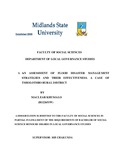Please use this identifier to cite or link to this item:
https://cris.library.msu.ac.zw//handle/11408/2434Full metadata record
| DC Field | Value | Language |
|---|---|---|
| dc.contributor.author | Khumalo, Maclear | - |
| dc.date.accessioned | 2017-06-30T13:35:22Z | - |
| dc.date.available | 2017-06-30T13:35:22Z | - |
| dc.date.issued | 2015 | - |
| dc.identifier.uri | http://hdl.handle.net/11408/2434 | - |
| dc.description.abstract | The study presents the introduction of the research in chapter one, justification of the study, research questions and objectives are well articulated. Chapter two of the study consists of theories underpinning the disaster risk management. Conceptual framework in chapter two seeks to invite the reader to understanding various concepts and the language of the nature of disaster and methods used to reduce its impact on livelihoods of the people living in flood disaster areas. Disaster Risk Reduction theories are presented and their critics and their applicability in different countries (developed and developing) as they are not universally applicable. The fact that disaster risk management requires strong financial base put developing countries at stack because of financial constraints they face, they always look for external aid to play a major role in the process. In the long run the concept of dependency syndrome is proliferated and deepens the level of vulnerability. However if all stages of disaster risk reduction well undertaken effects of disaster can be reduced. That is to say if structural and non-structural disaster mitigation strategies are undertaken in good faith and with commitment and political will flood disaster impacts can be reduced. The study appreciate that flood disaster have catastrophic effects both in developed and developing world but their impact are worse in developing countries especially in Africa. The area under study is located in one of the poor provinces in Zimbabwe with poor quality of education let alone scarcity financial resources; this means the area is vulnerable to natural disaster because the socio-economic livelihoods of the inhabitants depend on natural resources to survive. Some of the research findings are that the people living in flood prone areas are adamant to vacate the place because it is fertile so subsistence farming is booming. Those willing to vacate the place are interested only to be resettled in fertile areas with water and other basic services because their socio-economic livelihoods depend on subsistence farming. Therefore the study among other solutions, recommends that development of infrastructure, community participation, effective early warning is necessary in Tsholotsho, District and in Zimbabwe at large. | en_US |
| dc.language.iso | en | en_US |
| dc.subject | Disaster management | en_US |
| dc.subject | Floods | en_US |
| dc.title | An assessment of flood disaster management strategies and their effectiveness: a case of Tsholotsho rural district. | en_US |
| item.fulltext | With Fulltext | - |
| item.grantfulltext | open | - |
| item.languageiso639-1 | en | - |
| Appears in Collections: | Bsc Local Governance Studies Honours Degree | |
Files in This Item:
| File | Description | Size | Format | |
|---|---|---|---|---|
| Khumalo.pdf | Full text | 829.5 kB | Adobe PDF |  View/Open |
Page view(s)
134
checked on Nov 23, 2025
Download(s)
90
checked on Nov 23, 2025
Google ScholarTM
Check
Items in MSUIR are protected by copyright, with all rights reserved, unless otherwise indicated.



